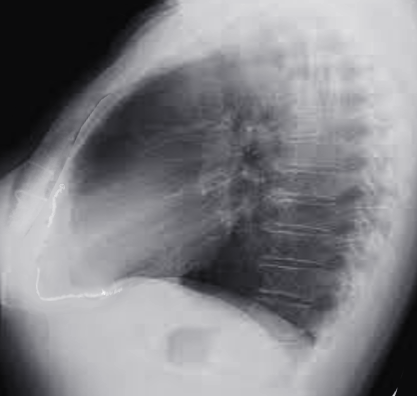[1]
Lehker A, Mukherjee D. Coronary Calcium Risk Score and Cardiovascular Risk. Current vascular pharmacology. 2021:19(3):280-284. doi: 10.2174/1570161118666200403143518. Epub
[PubMed PMID: 32242784]
[2]
Tu X, Hu Z, Yang K, Hu Z, Jiang Y. A case of bi-ventricular extensive calcification caused by multiple factors. BMC pediatrics. 2020 Feb 22:20(1):85. doi: 10.1186/s12887-020-1973-x. Epub 2020 Feb 22
[PubMed PMID: 32087707]
Level 3 (low-level) evidence
[3]
Pang J, Abraham A, Vargas-García C, Bates TR, Chan DC, Hooper AJ, Bell DA, Burnett JR, Schultz CJ, Watts GF. An age-matched computed tomography angiographic study of coronary atherosclerotic plaques in patients with familial hypercholesterolaemia. Atherosclerosis. 2020 Apr:298():52-57. doi: 10.1016/j.atherosclerosis.2020.03.001. Epub 2020 Mar 6
[PubMed PMID: 32171980]
[4]
Clemente A, Traghella I, Mazzone A, Sbrana S, Vassalle C. Vascular and valvular calcification biomarkers. Advances in clinical chemistry. 2020:95():73-103. doi: 10.1016/bs.acc.2019.08.002. Epub 2019 Oct 15
[PubMed PMID: 32122525]
Level 3 (low-level) evidence
[5]
Ahmed T, Inayat F, Haq M, Ahmed T. Myocardial calcification secondary to toxic shock syndrome: a comparative review of 17 cases. BMJ case reports. 2019 Jan 10:12(1):. doi: 10.1136/bcr-2018-228054. Epub 2019 Jan 10
[PubMed PMID: 30635313]
Level 2 (mid-level) evidence
[6]
Mori H, Torii S, Kutyna M, Sakamoto A, Finn AV, Virmani R. Coronary Artery Calcification and its Progression: What Does it Really Mean? JACC. Cardiovascular imaging. 2018 Jan:11(1):127-142. doi: 10.1016/j.jcmg.2017.10.012. Epub
[PubMed PMID: 29301708]
[7]
Saba SG, Makaryus JN, Rahmani N, Jadonath R. Histologic Sequelae of Apical Hypertrophic Cardiomyopathy: Dystrophic Calcification. Clinical Medicine Insights. Cardiology. 2017:11():1179546817710934. doi: 10.1177/1179546817710934. Epub 2017 May 29
[PubMed PMID: 28607546]
[8]
Díaz-Antón B, Solís J, Morales RD, López-Melgar B, Barrio P, Moreno A, Unzué L, Alvarez-Vieitez A, Medina J, García E, Jiménez FJP, Fernández-Friera L. Diagnostic and Prognostic Value of Coronary Computed Tomography Angiography in Patients with Severe Calcification. Journal of cardiovascular translational research. 2021 Feb:14(1):131-139. doi: 10.1007/s12265-020-09977-4. Epub 2020 Apr 1
[PubMed PMID: 32239435]
[9]
Han D, Beecy A, Anchouche K, Gransar H, Dunham PC, Lee JH, Achenbach S, Al-Mallah MH, Andreini D, Berman DS, Bax JJ, Budoff MJ, Cademartiri F, Callister TQ, Chang HJ, Chinnaiyan K, Chow BJW, Cury RC, DeLago A, Feuchtner G, Hadamitzky M, Hausleiter J, Kaufmann PA, Kim YJ, Leipsic JA, Maffei E, Marques H, de Araújo Gonçalves P, Pontone G, Raff GL, Rubinshtein R, Villines TC, Lu Y, Peña JM, Shaw LJ, Min JK, Lin FY. Risk Reclassification With Coronary Computed Tomography Angiography-Visualized Nonobstructive Coronary Artery Disease According to 2018 American College of Cardiology/American Heart Association Cholesterol Guidelines (from the Coronary Computed Tomography Angiography Evaluation for Clinical Outcomes : An International Multicenter Registry [CONFIRM]). The American journal of cardiology. 2019 Nov 1:124(9):1397-1405. doi: 10.1016/j.amjcard.2019.07.045. Epub 2019 Aug 23
[PubMed PMID: 31547994]
Level 2 (mid-level) evidence
[10]
Goździk AT, Jasiński M, Goździk W. Echocardiographic evaluation of left ventricular strain in severe aortic stenosis with therapeutic implications and risk stratification. Advances in clinical and experimental medicine : official organ Wroclaw Medical University. 2019 Sep:28(9):1271-1279. doi: 10.17219/acem/104553. Epub
[PubMed PMID: 31414735]
Level 3 (low-level) evidence
[11]
Chang SA, Oh JK. Constrictive Pericarditis: A Medical or Surgical Disease? Journal of cardiovascular imaging. 2019 Jul:27(3):178-186. doi: 10.4250/jcvi.2019.27.e28. Epub 2019 Apr 30
[PubMed PMID: 31161752]
[12]
van Rosendael AR, Bax AM, Smit JM, van den Hoogen IJ, Ma X, Al'Aref S, Achenbach S, Al-Mallah MH, Andreini D, Berman DS, Budoff MJ, Cademartiri F, Callister TQ, Chang HJ, Chinnaiyan K, Chow BJW, Cury RC, DeLago A, Feuchtner G, Hadamitzky M, Hausleiter J, Kaufmann PA, Kim YJ, Leipsic JA, Maffei E, Marques H, de Araújo Gonçalves P, Pontone G, Raff GL, Rubinshtein R, Villines TC, Gransar H, Lu Y, Peña JM, Lin FY, Shaw LJ, Min JK, Bax JJ. Clinical risk factors and atherosclerotic plaque extent to define risk for major events in patients without obstructive coronary artery disease: the long-term coronary computed tomography angiography CONFIRM registry. European heart journal. Cardiovascular Imaging. 2020 May 1:21(5):479-488. doi: 10.1093/ehjci/jez322. Epub
[PubMed PMID: 32065624]
[13]
Alderwish E, Schultz E, Kassam Z, Poon M, Coplan N. Evaluation of acute chest pain: Evolving paradigm of coronary risk scores and imaging. Reviews in cardiovascular medicine. 2019 Dec 30:20(4):231-244. doi: 10.31083/j.rcm.2019.04.589. Epub
[PubMed PMID: 31912714]
[14]
Yadgir S, Johnson CO, Aboyans V, Adebayo OM, Adedoyin RA, Afarideh M, Alahdab F, Alashi A, Alipour V, Arabloo J, Azari S, Barthelemy CM, Benziger CP, Berman AE, Bijani A, Carrero JJ, Carvalho F, Daryani A, Durães AR, Esteghamati A, Farid TA, Farzadfar F, Fernandes E, Filip I, Gad MM, Hamidi S, Hay SI, Ilesanmi OS, Naghibi Irvani SS, Jürisson M, Kasaeian A, Kengne AP, Khan AR, Kisa A, Kisa S, Kolte D, Manafi N, Manafi A, Mensah GA, Mirrakhimov EM, Mohammad Y, Mokdad AH, Negoi RI, Thi Nguyen HL, Nguyen TH, Nixon MR, Otto CM, Patel S, Pilgrim T, Radfar A, Rawaf DL, Rawaf S, Rawasia WF, Rezapour A, Roever L, Saad AM, Saadatagah S, Senthilkumaran S, Sliwa K, Tesfay BE, Tran BX, Ullah I, Vaduganathan M, Vasankari TJ, Wolfe CDA, Yonemoto N, Roth GA, Global Burden of Disease Study 2017 Nonrheumatic Valve Disease Collaborators. Global, Regional, and National Burden of Calcific Aortic Valve and Degenerative Mitral Valve Diseases, 1990-2017. Circulation. 2020 May 26:141(21):1670-1680. doi: 10.1161/CIRCULATIONAHA.119.043391. Epub 2020 Mar 29
[PubMed PMID: 32223336]
[15]
Zampella E, Acampa W, Assante R, Gaudieri V, Nappi C, Mannarino T, Mainolfi CG, Arumugam P, Petretta M, Cuocolo A. Combined evaluation of regional coronary artery calcium and myocardial perfusion by (82)Rb PET/CT in predicting lesion-related outcome. European journal of nuclear medicine and molecular imaging. 2020 Jul:47(7):1698-1704. doi: 10.1007/s00259-019-04534-x. Epub 2019 Dec 14
[PubMed PMID: 31836909]
[16]
Li M, Ye ZC, Li CM, Zhao WB, Tang H, Liu X, Peng H, Lou TQ. The influence of cardiac valvular calcification on all-cause and cardiovascular mortality in maintenance hemodialysis patients. International urology and nephrology. 2020 May:52(5):943-951. doi: 10.1007/s11255-020-02448-4. Epub 2020 Apr 1
[PubMed PMID: 32239335]

